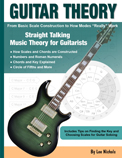The Chord Numbering System
Chord Numbers
Just like diatonic scale notes are numbered from one to seven, we also use numbers to denote the position of a chord relative to it's key (scale). Roman numerals are used to label chord positions. Using the previous example, the chords belonging to C major would be labelled from one to seven like this:
- I - C Major
- ii - D Minor
- iii - E Minor
- IV - F Major
- V - G Major
- vi - A Minor
- vii - B Dim
Note the use of lower case characters used for minor chords and upper case for major. This is common practice to write them this way.
By thinking about chords in terms of scale note positions, it becomes a much easier job to remember, or quickly figure out what chords belong to what key. All we need to know is the scale notes and a simple chord order. For instance, we have used C major for our example but it doesn't really matter what scale is used, the order of chords remains the same. We can use this to create a simple formula for any major key. So from one to seven, the chord types are ...
| I | ii | iii | IV | V | vi | vii |
| Maj | Min | Min | Maj | Maj | Min | Dim |
Using this idea it becomes a simple task to find the chords in any major key. Let's say we want to know what chords belong to the key of A major. All we need to know are the notes in the A major scale, then we find the chords like so ...
A major scale notes are A - B - C# - D - E - F# - G#
| A | B | C# | D | E | F# | G# |
| I | ii | iii | IV | V | vi | vii |
| A maj | B min | C# min | D maj | E maj | F# min | G# dim |
Extended chords In Key
The same idea is applied to extended chords. The chart below shows how.
| I | ii | iii | IV | V | vi | vii |
| Maj | Min | Min | Maj | Maj | Min | Dim |
| Maj 7 | Min 7 | Min 7 | Maj 7 | Dom 7 | Min 7 | min7b5 |
| Maj 9 | Min 9 | Min7 b9 | Maj 9 | Dom 9 | Min 9 | * |
| Maj 11 | Min 11 | **** | **** | Dom 11 | Min 11 | ** |
| Maj 13 | Min 13 | 1**** | **** | Dom 13 | **** | *** |
Notes
**** Sometimes chords can become very complicated, sound horrible and are hard to name accurately. It can also cause some controversy between musicians. For instance, the 5th chord in the sequence for E (1****) could be named Emin11b9b13. You could probably also name it something else but it all becomes very complicated and hard to define, it can also change with context.
The vii chords are not very common in their extended forms. These will be mostly used in jazz and will often use any form of diminished. Technically speaking the order of these chords after the min7b5 will be ...
- * half diminished ninth
- ** half diminished eleventh
- *** half diminished thirteenth
Chord Progressions
Chord numbering is a very effective way to communicate common chord progressions. When you hear terms like "one four five in G" or "two five one in B flat" these phrases are simply referring to the chords used relative to the scale position. For instance, as you can see from the diagrams below, a one four five in G would mean the chords G, C and D and a two five one in B flat would be Cm, F, Bb.
| G | A | B | C | D | E | F# |
| I | ii | iii | IV | V | vi | vii |
| maj | min | min | maj | maj | min | dim |
| Bb | C | D | Eb | F | G | A |
| I | ii | iii | IV | V | vi | vii |
| maj | min | min | maj | maj | min | dim |
You can of course use the extended chord versions so in Bb for example it would probably be more common to use the chords Cmin7, F7, Bbmaj7
Kindle book available from Amazon
Guitar Theory: Available on Kindle
Learn music theory that's worth knowing
Music theory can be complicated but we need to know it if we want to make sense of everything and improve our guitar knowledge and playing.
My latest book focuses mostly on the things that are really worth knowing, not so much on the rest. Start making sense of chords, scales, modes and finding the key to help you be more creative on the guitar.
Level: Advanced beginner and up.
Author: Lee Nichols Creator of www.guitar-chords.or.uk
(Sponsored Ad)
This website earns advertising commissions. To find out more about cookies, privacy and how we use advertising, please read our Advertising Disclaimer
Contact Info - Cookie and Privacy Policy
Copyright © 2007 - 2024 www.guitar-chords.org.uk


